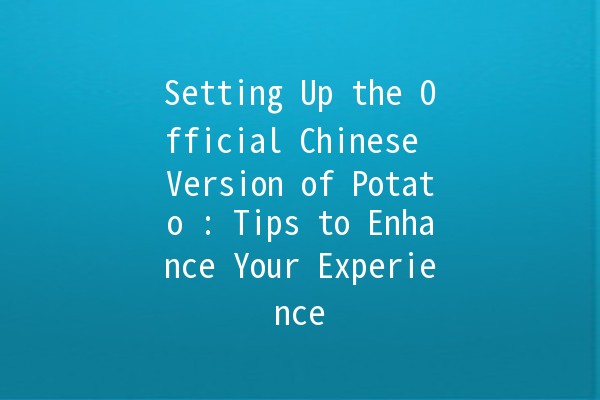In today’s digital landscape, effortless navigation and excellent usability contribute significantly to user satisfaction. For users exploring the official Chinese version of Potato software, this article will provide practical insights and tips to facilitate the setup process. By leveraging straightforward productivity enhancement techniques, you’ll be wellequipped to maximize the benefits of this software.
Understanding Potato Software
Before diving into the setup specifics, it’s essential to understand what Potato software is. It serves as a multifunctional platform catering to various user needs, including task management, application launching, and digital organization. Setting it up efficiently can dramatically improve your workflow. Let’s explore the steps to get started and the tools at your disposal.
Ensure Compatibility
Before proceeding with the installation, make sure your system meets the software's requirements. This ensures optimal performance and minimizes technical issues.
Operating System: Potato is compatible with Windows, macOS, and Linux. Verify that your version aligns with Potato’s specifications.
RAM and Storage: Depending on your use, ensure at least 4GB of RAM and 500MB of free disk space. For heavy users, consider expanding further.
Downloading Potato

Head over to the official Potato website and locate the download section for the Chinese version. Follow these steps:
Installation Process
The installation process is straightforward. After downloading:
Upon launching Potato for the first time, you’ll need to go through some configuration settings. This is crucial for a tailored experience.
Personalize Your Interface
Personalization improves usability, making navigation more intuitive. Here’s how you can do it:
Theme Selection: Choose a light or dark mode based on your preference. Dark mode can reduce eye strain during extended use.
Layout Customization: Adjust the layout to prioritize the tools you use most frequently. Use the draganddrop feature to reorganize icons.
Account Creation
For a seamless experience with personalized features:
Potato offers several productivity features that can streamline your tasks. Utilize the following tools to boost your efficiency:
Task Manager Integration
Task management is crucial for staying organized. Here’s how to use this feature effectively:
Creating Tasks: Use the builtin task manager to create tasks with deadlines. Assign priority levels to ensure you focus on what matters most.
Notifications: Set up notifications to remind you of upcoming deadlines. This keeps you on track and prevents lastminute rushes.
Application Launch Shortcuts
Enhance your workflow by creating shortcuts for applications frequently used:
Pinning Applications: Rightclick on your preferred applications and select “Pin to Potato.” This allows for oneclick access from the main interface.
Keyboard Shortcuts: Assign keyboard shortcuts to applications for quicker launches. This can save time during busy work hours.
Potato shines in collaboration capabilities, making it easier to work with teams. Here’s how to make the most of it:
Team Collaboration Tools
With features designed for teamwork, consider these steps:
Creating a Team Space: Set up a dedicated space within Potato for your team. Invite team members to join, allowing everyone to stay in sync.
Sharing Documents: Use the sharing option to collaborate on documents. Ensure everyone has the correct permissions to avoid disruption.
RealTime Communication
Seamless communication is essential when working in teams. Here’s how Potato facilitates this:
Chat Functionality: Engage in realtime chats with team members directly through Potato. This eliminates the need for external messaging apps.
Video Conferencing: Schedule video meetings within the platform to discuss projects and updates effectively.
Even the best software may encounter issues. Here’s how to tackle some common problems effectively:
Installation Issues
If you experience difficulties during installation, try these solutions:
Redownload the Installer: Ensure you’ve downloaded the latest version. Corrupted files can lead to installation errors.
Disable Antivirus Temporarily: Sometimes, an antivirus program may block installation. Disable it briefly and attempt the installation again.
Performance Lag
If Potato is running slowly, investigate the following:
Close Unused Applications: Ensure that other heavy applications are closed to free up system resources.
Regular Updates: Check for software updates within Potato. Regular updates can enhance performance and fix bugs.
Frequently Asked Questions
Here are six common questions users have regarding the Chinese version of Potato:
Yes, you can change the language settings at any time. Navigate to the settings menu, select “Language,” and choose your preferred language from the list. The changes will take effect immediately.
At present, Potato is primarily designed for desktop environments. However, there are plans for a mobile application in the future. Check the official site for updates on mobile compatibility.
Ensure your account is secure by utilizing a strong password and enabling twofactor authentication (2FA) in the security settings. Regularly changing your password adds an extra layer of protection.
If you forget your password, use the “Forgot Password” link on the login page. Follow the prompts to reset your password via the email associated with your account.
To uninstall Potato, go to your settings, navigate to “Applications,” select Potato, and click “Uninstall.” Follow the prompts to remove it from your system completely.
Potato offers a free version with essential features. There are premium plans that unlock advanced functionalities. Review the pricing model on the official website to see what’s included in each option.
Setting up the official Chinese version of Potato need not be a daunting task. By following the outlined steps and utilizing the productivity tips shared, you can streamline your experience significantly. From installation to configuration and troubleshooting, you now have a comprehensive insight into maximizing your use of this powerful software. Whether for personal or team productivity, Potato stands ready to enhance your digital workflow. Enjoy optimizing your new digital workspace!